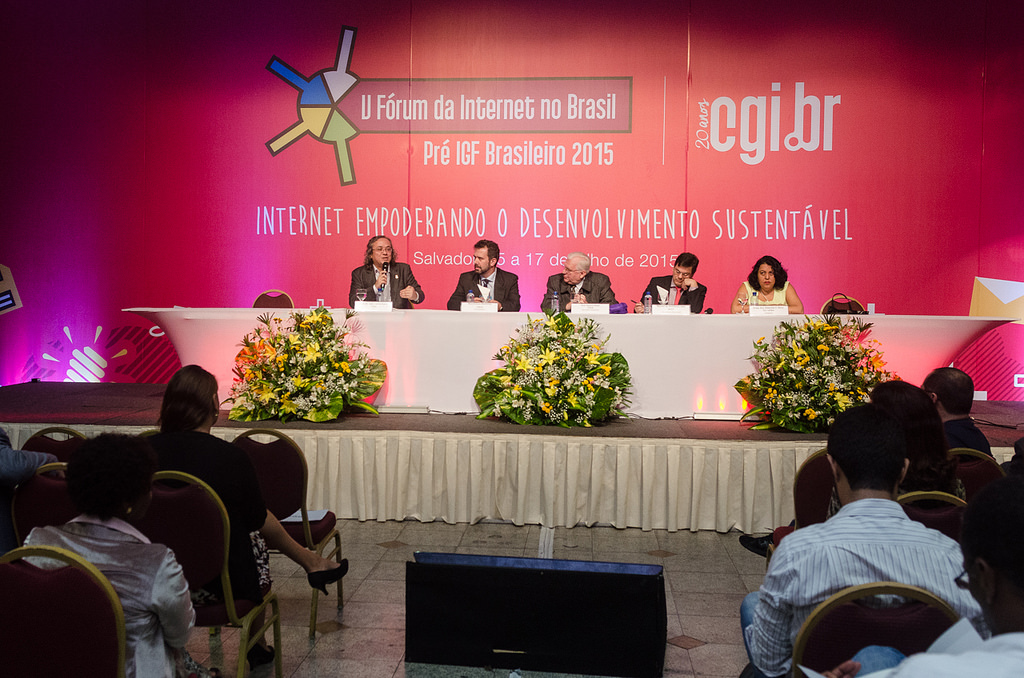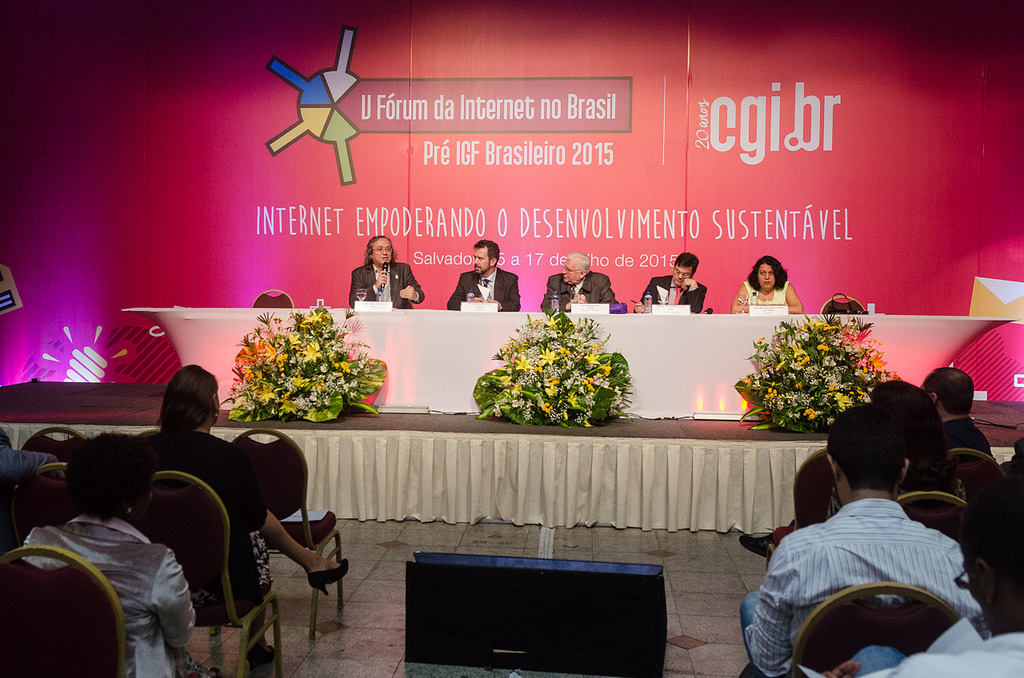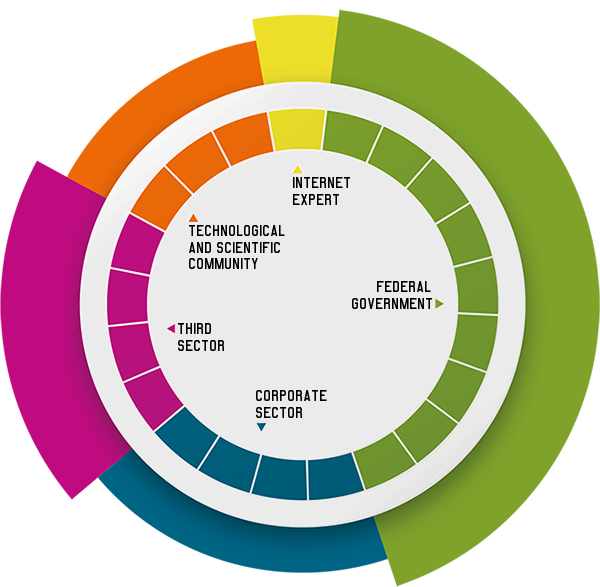
Brazilian Government wants to rediscuss the Internet Steering Committee: understand it here
In Brazil, the Internet Steering Committee (CGI.br) is the entity responsible for establishing strategic guidelines related to the use and development of the Internet in the country. On August 8th of this year, the Ministry of Science, Technology, Innovations, and Communications (MCTIC) started a public consultation to rediscuss the composition, the competencies, the functioning and the election process of the Committee. In this text, we analyze what is it, what’s the importance, what’s the structure and how does CGI.br work, aside from presenting the positionings, the preoccupations and the arguments which are at stake in this process of revision started by the public consultation.
What does the Internet Steering Committee do?
CGI.br’s history has a close relation to the history of implementation and dissemination of the use of the Internet in Brazil. In the 1990s, the use of the network was popular among academics, but with a timid adherence beyond these circles. In 1994, the Ministries of Communications and of Science and Technology released a new project aiming to expand the use of the web on the country which included, on the following year, the creation of the Internet Steering Committee in Brazil through the Interministerial Ordinance n. 147.
The Committee began to fulfill essential technical functions for the working of the web. One of them, for instance, is the function of coordinating the attribution of IP addresses to Internet connection providers, a protocol necessary in order to offer someone a connection to the Internet. CGI is also in charge of registering “.br” domain names: domains are the names which easily identify an address or a service, without the need of memorizing a sequence of numbers to find the sites. In Brazil’s case, these domain names end in “.br” and, over time, this activity became paid, currently being CGI.br’s largest revenue source.

CGI.br also has the function of issuing policy briefs on which standards and procedures should be adopted for the Internet services of the country. It also promoted studies and recommendations on Internet security and proposed research programs and development related to the web. The history of these studies is long and rich: researches supported by CGI showed the rapid evolution of the access and the use of the Internet in the country over the last 20 years.
Who is a part of the CGI.br and how does it make decisions?
Between 1995 and 2003, the Committee was formed by 9 representatives pointed by the government. In 2003, the Committee went through changes, pursuant to the Decree n. 4.829/2003.
This decree gave origin to CGI.br’s new institutional format, establishing a new composition of advisors and how the electoral process should be for their choice. In its current composition, the Committee is formed by:
9 representatives from the Federal Government (Ministry of Science, Technology and Innovation; Ministry of Communication; Presidential Cabinet; Ministry of Defense; Ministry of Development, Industry and Foreign Trade; Ministry of Planning, Budget and Management; National Telecommunication Agency; National Council for Scientific and Technological Development; National Council of State Secretariats for Science, Technology and Information Issues – CONSECTI.);
4 representatives from the corporate sector (Internet access and content providers; Telecommunication infrastructure providers; Hardware, telecommunication and software industries; Enterprises that use the Internet);
4 representatives from the third sector;
3 representatives from the scientific and technological community;
1 Internet expert (with broad knowledge on complex issues of the area).

The members of the corporate sector, the third sector, and of the scientific community are elected for mandates of three years and they are chosen from the votes of an electoral college of authorized entities from each sector. Only entities of the third sector can vote for representatives of the third sector, for example. The representatives of the government and the expert are, in turn, directly nominated by the Federal Government.
The Ordinance also created institutions which are subordinated to the Committee. This is the case of the Brazilian Network Information Center (NIC.br), the entity in charge of the administrative and operational functions of the CGI.br. On its current structure, NIC.br is responsible for guaranteeing and conserving the quality of the “.br” domain registers and for collecting the financial resources of the 3,4 million domains which are already registered.
The Committee does not have normative powers and it is not a part of the government: it is a multisectoral space (that is, a space that gathers different sectors, but in this case none of them has a predominance) for debate, for the creation of principles and guidelines, and for the administration of technical resources (such as domain names and IP addresses). The Committee actively took part in the process of elaboration of the Brazilian Internet Civil Rights Framework (Law n. 12.965/2014), offering the first guidelines for the creation of the law and being present in all of its proceedings. When it passed, the law made CGI.br’s role stronger, defining that it should be heard in matters related to the net neutrality and about technical requirements for the proper provision of services and applications.
The multisectoral model of the Internet Steering Committee
During its more than 20 years of existence, CGI.br became a reference, mainly due to its multisectoral processes and decisions, which place on the same table the representatives of diverse sectors to discuss the guidelines and strategies for the development of the Internet in Brazil.
The innovative format became a reference because it considers that the architecture of the Internet — global, decentralized and built from the contribution of multiple stakeholders — is complex and that its governance can be incremented from multiple perspectives. The key would be on the permanent consideration of the points of view of each sector, which differentiates this model from classic formats of institutionalization of international institutions and organizations. In more traditional models, for instance, the government sector would concentrate the power over what could be discussed and the decisions and strategies: there would not be the space for points of view outside of the state logic and that would encompass the complexity of topics and stakeholders so particular to the Internet’s own architecture.

With different positions at stake, the multisectoralism is at the center of the discussions about Internet governance held at international forums. Critics of this model sign that stronger groups (authoritarian governments or a strong private sector, for example) can use such spaces only as a way of legitimizing little open or transparent processes (which can be found here and here). For these critics, a larger opening for participation would not necessarily mean that groups can transform the debates into effective influences on the decisions or laws.
The public consultation: the government wants to rediscuss the Committee
Last August 8th, the Ministry of Science, Technology, Innovations, and Communications (MCTIC) released a public consultation aiming to review the institutional design, the functions and the competences of the CGI.br. The Ministry argued that the necessity of harmonizing the structure of the governance of the Internet to the new processes of digital transformation was the reason behind it. In the base-document of the consultation, they emphasized the importance of multisectoral institutions, of the further development of transparency and participation, of the adoption of transition measures between the current structure and eventual new rules and, at last, of the preservation of its multi-participatory and democratic character, constantly balancing the represented sectors.
This proposition by MCTIC of rediscussing CGI.br took the members of the committee and of the community that follows internet policy topics by surprise. The political moment is turbulent and guided by a daring and controversial reformation agenda by the government on different fronts, which leads to doubts. What will be the impact of this measure?
Reactions to the consultations: polemics and fears
The Federal Government’s intentions with the consultation were immediately questioned by a series of stakeholders from different sectors. The Coalition For Rights on the Web, which congregates different organizations from the civil society, and the Internet Society Brasil (ISOC), the Brazilian branch of an international organization for the promotion of the web, defended that the consultation should be immediately canceled. These critics argued that the process was conducted in a unilateral manner by the government, once there was no previous dialogue within the Committee about the subject. Congressman Orlando Silva (PCdoB-SP) also criticized, on the Chamber, the opening of the public consultation, arguing that he would send requests for clarifications by MCTIC. There were also defenders of the government’s action: Samuel Possebon, a journalist specialized in the telecommunications market published editorials before and after the release of the public consultation, arguing that “it is time to change” CGI.br. These initial movements draft a conflict between the representatives of the third sector and of the scientific community on one side, and of the Internet connection providers and the government, on the other.
Among so many critical manifestations, the Ministry published a text attempting to explain the reasons for beginning the process, affirming that the consultation was released with the aim to “gather supplies” in order to assess the necessity of modernizing the Committee. On the text, it indicated that it wants the continuity of the minoritarian participation of government representatives in relation to other sectors.
Debates: what has already been discussed in the public consultation?
On the public consultation installed by MCTIC, the participation happens in 5 “axes”, that in their turn refer to key-points of the functioning and composition of the Committee: the “competence” (possible updates and improvements to it); the “composition” (a discussion about current sectors and if there is the need to include other sectors); the “election and mandate” (contributions to improve the process); the “transparency” (improvement of the mechanisms and transparencies); and “other considerations”.
Being open for a week and a half, the main issues raised questions about the processes of reelection of the CGI.br members and the weight of the government on the decisions and nominations. The participants also highlighted the need for the publishing of the expenses, monthly reports on the meeting agendas and even the availability of platforms for the direct, digital and interactive consultation about the decisions and deliberations made by CGI.br. At last, there was also the need for extending the deadline for the consultation, which is only 30 days.
InternetLab’s role: analyzing the context and mapping the positions on the debate
The lack of consensus in relation to the format and to the moment of proposing the consultation and concerns about the eventual outcomes of the process make it essential to follow it closely. Thinking of this, as we did on other public consultations (like here and here), InternetLab will elaborate a report on the public consultation, analyzing its political context and mapping the debated topics, the main arguments and the stakeholders involved.
By Clarice Tambelli and Francisco Brito Cruz
Collaboration: Beatriz Kira
Translation: Ana Luiza Araujo